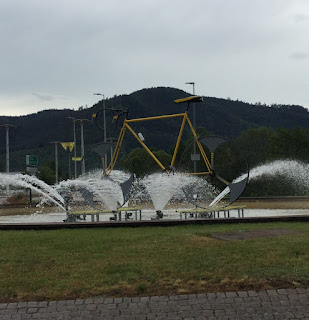The route the peloton will take out of Saint-Dié-des Vosges.
A bridge the peloton will cross in Saint-Dié-des-Vosges.
A giant bike in a roundabout outside Saint-Dié-des-Vosges.
One of many posters in Colmar promoting the coming of The Tour.
The countdown to the coming of The Tour in Mulhouse.
A memorial to René Pottier at the summit of the Ballon d’Alsace for being the first to cross it in the 1905 Tour de France.
A monument to those killed defusing land-mines at the summit of the Ballon d’Alsace.
A tribute to the Rubic’s Cube in a roundabout in Dombasle-sur-Meurthe
I had to dig into my emergency rations when I was caught by a surprise French holiday on Monday and all the supermarkets were closed. It was the Pentecost. It comes 50 days after Easter Sunday, so the date varies from year to year. Luckily I still had six slices of bread for what peanut butter and honey I had left, as well as a pack of Ramon and a couple packs of instant oatmeal as well as some Madeleines and two canisters of apple sauce. I’ve switched from one large heavy glass jar of apple sauce to a four-pack of 125-gram containers in much lighter plastic. I had to dig deep into my panniers to find them, not sure if I had any left. Usually I have some couscous and corn flakes, two of my staples, but they had both run out the day before.
I almost had to resort to a McDonald’s, as there was one on the outskirts of Saint-Dié-des-Vosges, Ville Départ for stage five. The journalists following The Tour are always happy when a Ville Étape has a McDonald’s, as it is a source for WiFi. I feel the same, though slightly less so this year, as for the first time it is blocking blog sites with the explanation that its content could be suspect.
Along with the the Yellow Arches, Saint-Dié-des-Vosges abounded with Yellow Bikes. They were everywhere—all over this town of 20,000 and along the road leading into it, in roundabouts, and mounted high on pedestals. The main boulevard the peloton will depart on was an arcade of large banners declaring “C’est Notre Tour” with the “O” a bicycle wheel. A bridge the peloton will cross was fully decorated with wooden cutouts of the jerseys and a rider on a bike.
The town expressed its enthusiasm about the coming of The Tour as every town should. All eyes of the cycling world will be upon it as it launches the first meaningful stage of The Tour with its first dose of genuine climbing, a pair of category two climbs in the Vosges on the way to Colmar. It will give the riders a taste of what is to come on the next day’s killer stage to La Planche des Belle Filles with four category one climbs.
Colmar hadn’t done anything significant to promote The Tour, just mounting a bunch of perfunctory posters, that had least had an original rendition of a cyclist with a labyrinth of lines. Colmar was aswarm with tourists, many of them Asian, wandering the old cobbled streets of this German-flavored city.
The Ville Départ for the next stage, the even larger city of Mulhouse with a population of over 100,000, only had a large box, similar to the one in Belfort, with a digital countdown to Tour Day and a list of Tour-related events leading up to it, mounted in front of the city’s cathedral. I am regularly drawn to Mulhouse as it is the home of my fellow cycling fanatic Yvon. Unfortunately it was in Belgium, so I’ll have to wait until The Tour for our annual reunion.
As I have in the past I came into Mulhouse over the Col du Ballon d’Alsace, a category one climb the peloton will tackle on stage six on the way to La Planche des Belle Filles. It is noteworthy for being the first significant climb introduced to The Tour in its third edition in 1905. The first two routes crossed an equally high climb, the Col de Republique outside of St. Étienne, but the grade wasn’t as steep as the seven per cent of the Ballon d’Alsace.
Henri Desgrange hyped the Ballon wondering if any of the riders would be able to get over it on their one-speed bikes in the pre-derailleur era without having to get off and walk. René Pottier managed it. He was the first over, but the effort took so much out of him, he abandoned The Race. He was first over again the next year and went on to win The Race. A plaque at the summit acknowledges his feat. He was the first of several Tour winners to commit suicide. He hung himself in 1907 when he discovered his wife had taken a lover while he was winning that 1906 Tour.
Also at the summit is a monument to those who defuse land mines. It is called “L’Homme Projeté” (The Propelled Man) showing a man sent airborne by an exploded mine. Among the spectators was a guy wearing a red-dotted hat that had been dispensed by The Tour de France caravan.
On the descent into Mulhouse, about thirty miles away, I could hear the sound of metal on metal coming from my front wheel as I braked. The steep descents of the past couple of days had worn down my front brake pads. The rear were fine, as I’d needed to replace them on the way to Cannes. As always, I began the trip with four spare brake pads along with three spare tubes and spare brake and derailleur cables and chain and the requisite tools, adding a few pounds to my load. The new pads should get me through this tour and a couple more, but to be safe, I’ll pick up one set of spares at the next Decathlon I come upon.









No comments:
Post a Comment